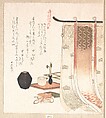Screen and Utensils for the Incense Ceremony
Kubo Shunman Japanese
Not on view
Surimono, literally "printed matter", are high-quality, limited-edition, privately commissioned, woodblock-printed "greeting cards," mainly produced between the 1790s and the 1830s, and usually ordered for New Year's greetings. On this surimono by Shunman, we can see preparations for an incense ceremony: an incense tray is depicted with an incense heater and tools for burning the incense. A piece of hot charcoal is placed in the ash to warm the small piece of incense wood, so it can release its fragrance. The ash and the charcoal are handled and shaped with the fire tools. The preparations take place behind a curtained partition, which suggests a wedding or a special celebration. There are three poems depicted on the print. The first poem suggests a wedding; the second, a hazy spring moon and plum flowers; and the third, Mount Fuji and the first song of spring by the bush warbler. All the motifs have auspicious meanings, as they evoke spring and therefore the renewal of life—appropriate symbols for a New Year's greeting.
Due to rights restrictions, this image cannot be enlarged, viewed at full screen, or downloaded.

